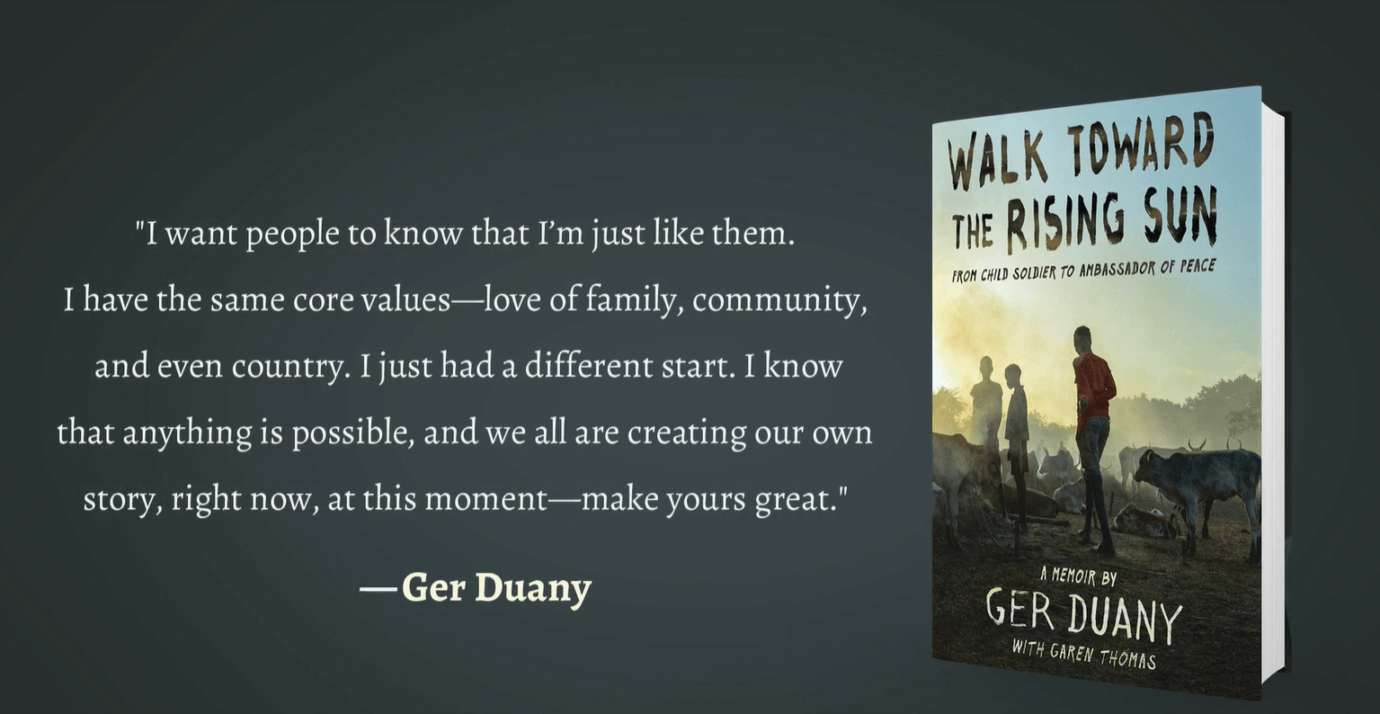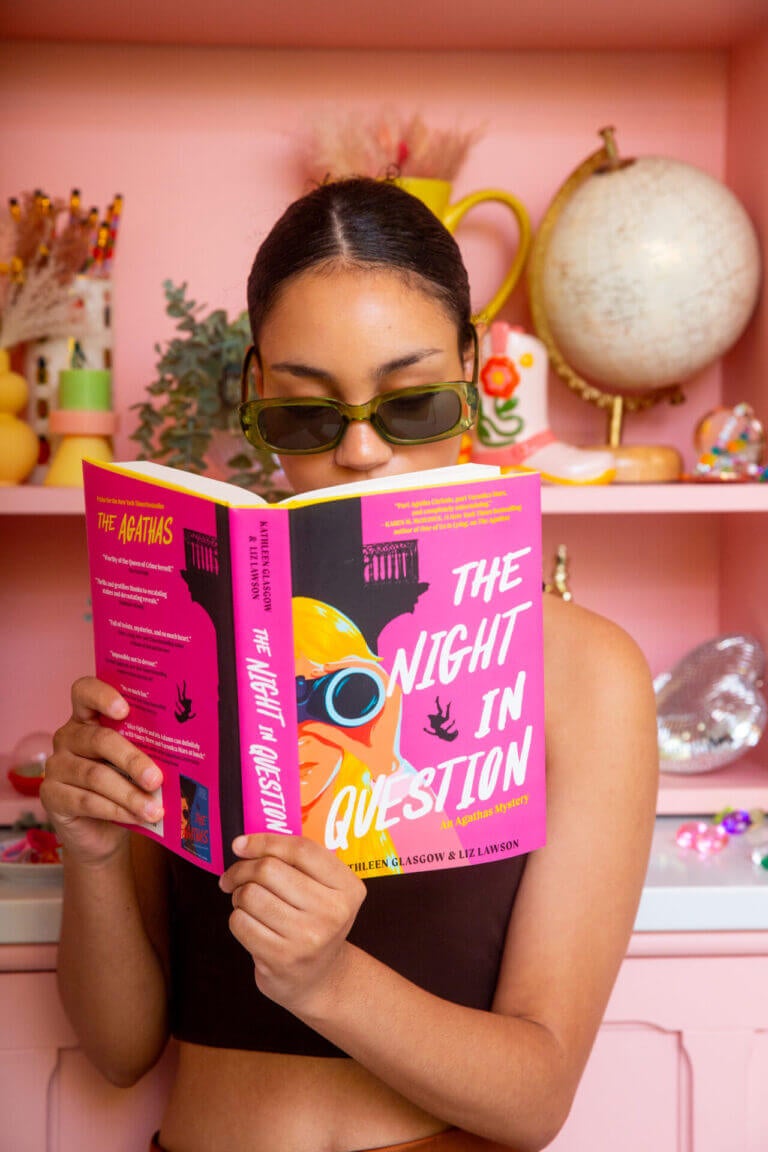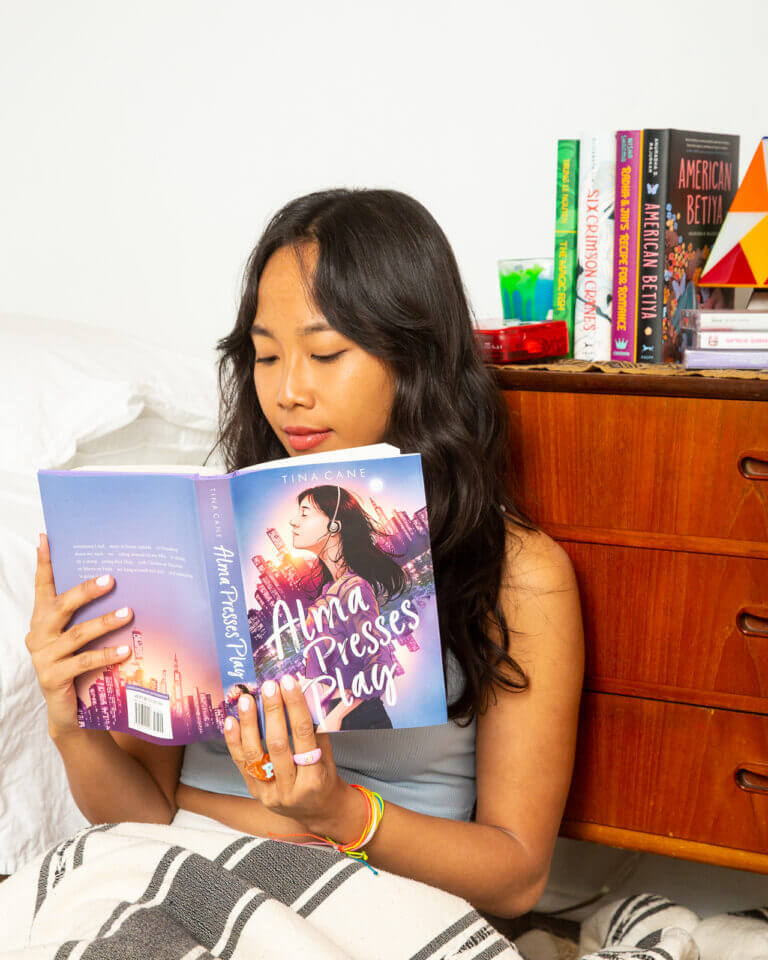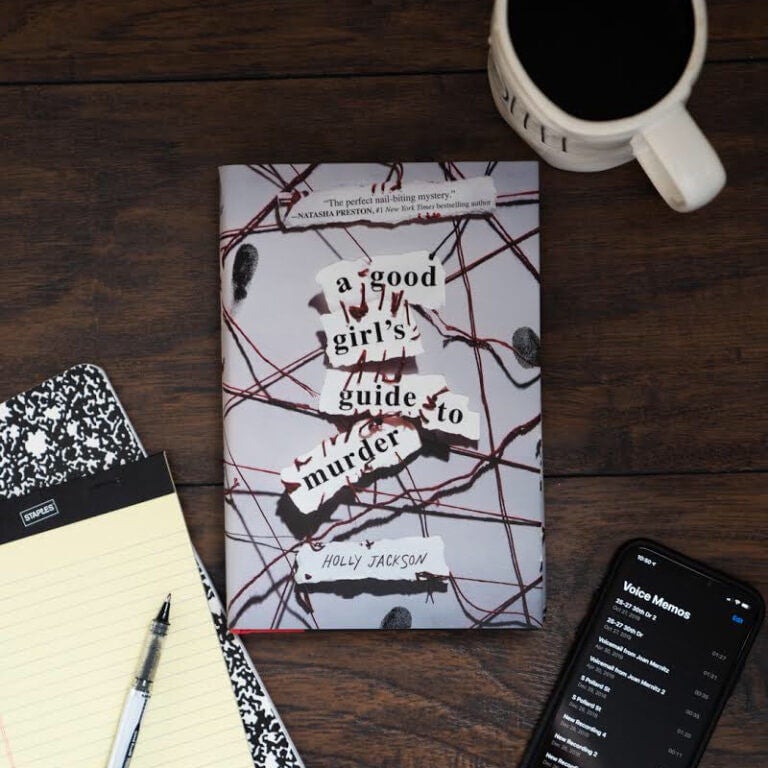One of our favorite Book Nerd activities is going to book club! Book clubs create community, help us get through our TBR pile, discover new faves, and allow space to talk about our favorite characters. To help with your book club endeavors, we’ve created book club guides for some of our favorite YA titles. This Walk Toward the Rising Sun book club guide will help you get the most out of reading about Ger Duany’s awe-inspiring life. Dive into these insightful pre-reading, during reading, and post-reading discussion questions and activities. This guide, originally created by Bryan Ripley Crandall and Abu Bility for teachers and librarians, was adapted in this article to be used by book clubs and anyone who would like to get the most out of Walk Toward the Rising Sun.

Letter from Walk Toward the Rising Sun guide creators Bryan Ripley Crandall and Abu Bility
Dear Readers,
This guide for Ger Duany’s Walk Toward the Rising Sun comes after more than a decade of collaboration, mentoring, teaching, learning, and friendship. Our work with literacy, refugee relocation, history, storytelling, and youth advocacy is why we were honored and thrilled to be part of this book’s introduction to educators and librarians.
Abu and I met in 2009 when we were paired in a collaboration between Syracuse University and Syracuse City School District. One of us was a relocated refugee youth from Liberia and the other was a teacher doing doctoral work in English education. Dr. Kristiina Montero had a vision for using oral history methodologies to help students of English as an additional language share their lives. We met in a library regularly, read together, shared memories, and began writing. We started to make sense of the world around us, and we became family.
Eleven years later, our collaboration continues. We are now both educators—one directs a National Writing Project site in Connecticut, and the other coaches and teaches at Syracuse Academy of Science. We are testimony that books like Walk Toward the Rising Sun are windows, mirrors, and sliding glass doors (Bishop, 1990). We are evidence that #WeNeedMoreDiverseBooks, especially those that cultivate genius in every student through equity frameworks for culturally and historically responsive literacy (Muhammad, 2020).
We should be celebrating the “Mother of Exiles,” who asked for “huddled masses yearning to breathe free,” but there remain many who seek walls and cages to deflect and laws to demonize those who flee from hardship, hunger, violence, and war. It is why this book is important. Our students need more opportunities to read refugees’ stories, and refugees need more books that reflect their experiences and share their stories.
Diverse books cultivate voice in young people, showing them their stories matter and deserve to be heard. And when they have found their voices, they are better prepared to share their lives with others.
Walk Toward the Rising Sun will be a window, a mirror, and a sliding glass door for many. Teachers who share this story should also offer a microscope and a telescope (Carroll & Hassan, 2004) to their students—that is, an opportunity to look closely at every detail with a critical eye and to project the ideas they gain into the future. It is a memoir for our nation, one that celebrates the lost voices of refugee youth (Crandall, 2014) and assures that history comes first (Crandall, 2018). Ger Duany’s journey resonated with us for numerous reasons. It helped us to make sense of the world around us. It reminded us to persevere.
We created this guide with teachers like us in mind—teachers who work toward social justice and who desire education systems that benefit all youth. We hope our guide enhances Ger Duany’ s memoir and offers multiple ways for you to approach this beautiful book with students, in book clubs, and for yourself.
Ubuntu,
Bryan Ripley Crandall and Abu Bility
Pre-Reading Prompts and Activities
Walk Toward the Rising Sun by Ger Duany (with Garen Thomas) addresses the importance of finding hope, even during the darkest times. It is a story of perseverance, coincidence, loss, love, and home. With knowledge of the young people you work with, you can use and adapt the following pre-reading prompts and activities.
Option 1: Writer’s Notebook
Before reading, collect your thoughts by freewriting for ten minutes on any of the following prompts. You can write, list, doodle, draw, or do all four together. The goal is to capture their ideas for yourself.
Scars. Do you have a scar? What is it? How did you get it? What’s the story behind the scar? (Note: scars can be physical or emotional.)
Home. What is your definition of home? Where is home for you? Why that place? Is there a person who needs to be present to make a place home? What other things are there? Are they important? Why? What does your home mean to you?
Mentors. What is a mentor? What do they provide and offer? What makes someone a good mentor or a bad mentor? Do you have a mentor? Are they important to you? Why?
Life Skills. Hoops 4 Hope, a nonprofit that supports youth programming through sports, promotes the following skills for life: focus, integrity, sense of humor, responsibility, self-esteem, self-awareness, and ubuntu (a philosophy for human togetherness and community). Which life skill is most important to you? Is it one of these or another? Explain your choice and share a story explaining why you believe this is the most important skill.
Rituals. A ritual is a ceremony that consists of actions that represent a special celebration, rite of passage, or time of growth. Think about the communities you belong to. Do these communities have any rituals? Choose one and describe it.
These initial prompts can be revisited after reading the text. Teachers can ask students to connect what they originally wrote with something in Ger Duany’s memoir.
Option 2: Anticipation Statements
Read the following statements aloud. Each person can state whether they agree or disagree. Each statement can also be discussed.
- The sun supplies the world with hope.
- Good news tends to travel with a chaperone—bad news.
- Scars are what carry us far.
- There are three things one needs in life: education, education, and education.
- An individual is only powerful when in the company of others.
Family History
Walk Toward the Rising Sun focuses on Ger Duany’s familial history. Throughout his journey from boyhood in Akobo, Luet, Sudan, to activism in the United States, he remains tied to his Nuer culture, his home country, his traditions, and the conflict that uprooted his family. As you read, encourage students to explore their family histories.
- How far back can your family lineage be traced? Can it be traced to another country? Do you know any stories about the relocation? Was the relocation voluntary or involuntary, and what effect did that have?
- What traditions do you uphold with your family? How does your family celebrate your culture(s)? Does your family have norms and rituals? Are there any heirlooms or artifacts your family holds dear? Do you have special food? Music? Sports? Hobbies?
- If your family relocated to America, what do you know about the history of your family’s home nation(s)? What are the milestones in those countries? Important dates and people? What drives the economy? What did your relatives do there?
- Who are the storytellers in your family, and what do they share? Who do they share stories with? How do they teach you about your history?
- What expectations does your family have of you? Are they the same for everyone in the family? What advice do they give you most often?
Writing Extension-Memoirs and Narratives
Walk Toward the Rising Sun is a memoir, a historical account or biography written from the perspective of one person. In the book, Ger Duany explores childhood, war, survival, refugee camps, life in a new nation, sports, family, high school, college, the theater, a modeling career, relocation, depression, and hope. Memoirs are stories that link a writer’s insights about themselves to their world.
Memoirs . . .
- Offer first-person point of view throughout
- Focus on several events, people, and places
- Use imagery to describe events and show their importance through sensory-rich language
- Explore particular times and memories
- Share feelings and thoughts to connect with the audience
- Capture dialogue succinctly and intentionally • Unravel why the shared memories are important and significant
Personal Narratives . . .
- Offer first-person point of view
- Explore a moment or an event—the story, the place, the people involved
- Show change in how the narrator thinks, understands, or behaves
- Describe with sensory language
- Share feelings and thoughts with the audience
- Capture dialogue and thoughts
- Unravel why the moment in time mattered
Exploring Personal Stories
Young people live rich, complicated lives, influenced by many communities, both in and out of school. The best memoirs choose an idea and share many snapshots and moments over time that offer perspectives on that idea. A personal narrative usually focuses on a single event. Brainstorm possible writing ideas with students so they have options for their own writing. Here are some examples: sports, birthdays, that one relative, a special vacation, friendships, loss, the happiest time, the saddest time, overcoming obstacles, a valuable lesson, illness, the games of childhood, first job, an unforgettable achievement, family pets, getting in trouble, the best advice, the best birthday present ever, revenge, a pleasant surprise.
Reading as a Writer
Consider the following questions while reading Walk Toward the Rising Sun about Ger Duany’s (and Garen Thomas’s) writing and style.
- What makes this book personal? Are some parts more personal than others?
- What specific memories stood out to you? Why?
- In “The Hunt,” Ger Duany details a childhood memory where he felt like a champion. What happened in the moment he explores? How does he set the memory up? Is there a beginning, a middle, and an end? How is dialogue used? What do we learn about Ger?
- Ger Duany uses imagery and rich language. Find some examples. How does the descriptive language help readers?
- Throughout the memoir, Ger Duany uses dialogue with intention. Locate places where dialogue is used, and discuss what the dialogue adds.
- What moments from Ger’s life impacted you the most? Why? Did he choose image-rich language or more straightforward narration for these moments?
- A memoir offers snapshots over a lifetime, often to arrive at an epiphany or change in view. How do the author’s views of his world and of himself change over time?
During Reading
Walk Toward the Rising Sun is a rich story, full of history, events, and people. As you read the memoir, it may be important to focus on themes and impactful moments. The following questions can be used to prompt individual thinking, small group discussion, or large group activities.
Chapter Titles. Ger Duany’s memoir is divided into three parts, grouping chapters around childhood, war, and relocation to a new nation. How do the titles of each chapter work together to build theme?
Family. Ger Duany’s family is large, with numerous relatives named throughout the memoir. The family tree may help readers to map an individual’s influence on his life while they read. How does Duany explore family in Walk Toward the Rising Sun? What importance does family have, both in Africa and in the United States?
Growing Up. Part 1 of Walk Toward the Rising Sun details much of Ger Duany’s childhood. Part 2 captures early adolescence. Part 3 begins with later adolescence and ends with early adulthood. What was remarkable about how the author grew up? What was normal and universal? What was challenging and difficult? How did he explain his growth throughout?
Loss. Ger Duany shares many losses, not only from within his immediately family but throughout Sudan and the surrounding countries. How do Ger and his family deal with their losses? How does Ger deal with loss later in life?
Bravery. Throughout the memoir, individuals model bravery in many different ways. How does the author see bravery? How is he brave? Is it brave to share a story like this? Why or why not?
Being an Adult. Elders in Ger Duany’s life, including his parents in Sudan and mentors in the United States, had tremendous influence on who he would become. Who does Ger look up to? What do they teach him about adulthood? How does his perspective on being an adult change in each part of the book?
The Immigrant Experience. Ger Duany arrives in the United States as a teenager and experiences airplanes, hot showers, and American culture for the first time. How does he react to the transition? Is it easy? Difficult? How does he make sense of the world he left behind? How does he make sense of the new world presented to him?
Education. Ger Duany describes the small taste of education he received in the refugee camp and details his education upon arrival in the United States. Throughout his childhood, his experiences as a child soldier, and his professional career, he is always learning. How does he view education? How does his perspective on education change throughout his life? What responsibility does he have toward it?
Questions to Ask Those with a History of Seeking Refuge
- How do you share your story of coming to America with teachers and friends?
- How can we teach American students about the struggles you faced?
- How can we help our teachers better support students like you?
- Why is it important to share what you have overcome?
- How can you use your story to elevate yourself ?
- What do you want others to know about your story?
- What advice do you have for newcomers to the United States?
Post-Reading Dialogue
Use the following to encourage and make text-to-world and text-to-self connections. You can include parents, teachers, and administrators in these group conversations. It is okay if participants stray from the questions, as long as they are engaged. Create ten to twelve questions (or use the examples below), and cut them out so they can be stapled into a book. Split into groups of four to five. Every group member answers every question. The activity usually lasts approximately thirty to forty-five minutes. Or, if you are engaging in distance learning, have students join break-out groups to video conference a discussion.
Questions for Walk Toward the Rising Sun by Ger Duany
These dialogue prompts are designed to initiate a conversation between you and others. It’s okay to stray from the questions here, but be sure to return to them if you get too far off topic.
- Icebreaker: Ger has many nicknames given to him throughout his life. Tell everyone your full name and any nicknames given to you by your friends and family.
- The title of the book is Walk Toward the Rising Sun. Are you a sunset person, a sunrise person, or someone who prefers the moon or rain? What is something in nature you like to look at (walk toward) when thinking about your life? Do you have a favorite spot to think and relax?
- Ger often is compared with his father and hears “Like father, like son.” Often while growing up, family members compare us to others in our family and/or community. Has your family told you that you are similar to someone? If so, who?
- Some argue that empathy is one of the greatest qualities a human can have. Empathy is the ability to show concern and to understand the feelings of others. Ger experiences a lot in his life that might elicit empathy from others. After reading his story, what would you want him to know? What would you want to tell him?
- What does Ger think about education when he attends school in the refugee camp, when he tries to find his way in an American high school, and when he eventually goes to college?
- Speaking of school, what’s a great memory? What’s a not-so-great memory? What hopes do you have for your future and education?
- Ger, like many boys his age, found support through participating in the SPLA. He became a child soldier fighting for the cause of south Sudan. Think about what it must be like to fight as a child and what one loses when they do. What is one word to summarize what you think of this? Why did you choose this word?
- One person whom Ger looks up to and who guides him through childhood and as a figure for life is his brother Odor. How did Odor influence Ger? Do you have a sibling, cousin, relative, or community member who helps to guide your path? How do they do that?
- Ger writes, “In Nuer culture, people don’t show physical pain, but emotional pain is different. When we’re happy, we dance and sing; when we’re sad, we mourn; and when we’re angry, we fight. Nothing is held inside . . .” (p. 24). How does your family and your culture handle emotions? How do you?
- When Ger moves to the United States, he describes “The Loop” that attracted teenagers to hang out, show off, and do teenager things. Do you have such locations—spaces for gathering and being with kids your age? What are they?
- Last question—actually a task. As a group, write three sentences about Walk Toward the Rising Sun that you would read to others who haven’t read the memoir.
Resources and Extensions
Music
- Ger Duany alludes to his friendship with musician, actor, and activist Emmanuel Jal. Teachers may share Sudanese artist’s song “Scars” to initiate conversation about themes found in Walk Toward the Rising Sun. The video can be found on YouTube: youtube.com/watch?v=tYCBRKP_Tvo
Websites
Several websites provide contextual information useful for teaching about immigration and the refugee experience.
- UNHCR. Ger Duany is a Goodwill Ambassador for the United Nations High Commissioner for Refugees which has provided assistance since 1950. unhcr.org/en-us
- IRC. The Interactional Rescue Committee helps people whose lives and livelihoods are uprooted by conflict and disaster. rescue.org
- H R W. Human Rights Watch investigates and reports on abuses around the world. hrw.org/topic/childrens-rights/child-soldiers
Media
- Lost Boys of Sudan written and directed by Megan Mylan and Jon Shenk (documentary film) Available on PBS: pbs.org/video/pov-lost-boys-sudan
- The Good Lie written and directed by M. Nagle and P. Falardeau (film)
Academic Texts
- The Lost Boys of Sudan: An American Story of the Refugee Experience by M. Bixler
- Not Just Child’s Play: Emerging Tradition and the Lost Boys of Sudan by F. R. McMahon
- Educating Refugee-Background Students: Critical Issues and Dynamic Contexts by S. Shapiro, R. Farrelly & M. J. Curry
- Children of War: Wandering Alone in Southern Sudanby J. Zutt
This guide was prepared by Dr. Bryan Ripley Crandall, Connecticut Writing Project director and associate professor at Fairfield University, and Abu Bility, teacher, Syracuse Academy of Science.
Check out Walk Toward the Rising Sun
About the Author
Ger Duany is a survivor of the tragic exodus of an estimated 20,000 Sudanese children, known as the Lost Boys of Sudan, and has been appointed a UN Goodwill Ambassador. Born in the town of Akobo, Ger was caught up in Sudan’s civil war and forcefully recruited to be a child soldier. At the age of fourteen, he managed to escape to neighboring Ethiopia and was eventually resettled to the United States from the Dadaab refugee camps in Kenya. In 2014, the United Nations High Commissioner for Refugees helped Ger reunite with his mother and other family members in Kenya’s Kakuma refugee camp. In the United States, he became a model, an actor, and an activist. To learn more about Ger, his inspiring life story, and his work to help refugees around the world, visit GerDuany.com or follow @GerDuany on Twitter.





